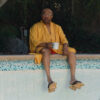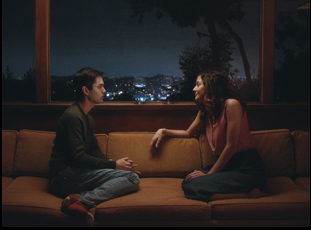It is the unfortunate way of life for most filmmakers to spend seven years working on something and if they’re lucky, have it all go by in a blink when it goes into production, as James Sweeney would come to discover during the making of his zippy first feature “Straight Up.”
“I had to remind myself to enjoy this because it was so quick and I was so stressed out the whole time that I think other people had fun on set, but I was just like, ‘Gotta get it done, gotta get it done, gotta get it done,’” says Sweeney, who was the only producer on set besides his responsibilities as an actor, writer and director. “But I can look back on it with great admiration and I was so sad the day we wrapped. I feel most alive when I’m on set, so it makes me eager to get to do it again.”
Certainly, “Straight Up,” one of the real discoveries on the festival circuit in recent memory, will leave audiences wanting a follow-up as much as the actor/writer/director since Sweeney turns whatever frantic energy there was on the low-budget indie shoot into a dazzling romantic comedy where the one-liners fly fast and furiously, throwing one into a tizzy as readily as its leads Todd (Sweeney) and Rory (Katie Findlay) push each other off-kilter. A perfect match spiritually, the software coder/housesitter and aspiring actress are less ideally matched physically when Todd, thought to be gay by his closest friends, has no interest in sexual intimacy, and Rory, although accepting initially, grows to realize their relationship may always feel as if something’s absent without it.
As potentially precarious a scenario as that may sound in the wrong hands, “Straight Up” is held together by the strong chemistry of Sweeney and Findlay, for whom wisecracking this potent hasn’t been seen since the days of “The Thin Man”’s Nick and Nora Charles. The filmmaker also has an equally strong eye as his ear for dialogue, which creates a sweetly nostalgic portrait of Los Angeles as a city where every one arrives with dreams of becoming someone else with oceanside views and bright lights to suggest a world of possibilities, but doesn’t ignore the realities of two people running up against the limitations imposed on them by society or their own imaginations when they don’t fit as easily into cultural norms as easily as the Old Hollywood square frame that Sweeney places them in. It’s as delightful a feature debut as they come, and on the eve of the film’s national theatrical release beginning this week in New York, the multi-hyphenate spoke about having such irrational self-confidence to deliver this something this bold straight out the gate, the happy accident that became an instantly iconic image for the film, and finding an ideal acting partner in Findlay.
It’s been in the making for quite some time. I started writing the script back in 2013, so we made a proof of concept back in 2016 for Fox Digital called “Normal Doors,” which was based off the feature script. Their whole paradigm at the time was casting influencers and I was really intent on casting myself, so we made that short and for the next two years, the film was almost greenlit and then fell apart at the last second. In 2018, I was like I have to make this movie before I die, and if it doesn’t happen now, it’s never going to happen, so I decided to do a crowdfunding campaign and crowdfunding was the most stressful moment of my life, but it held me accountable because I told all the people in my family that gave to the campaign that I owed them a movie, so we filmed it that October in 2018.
This brims with confidence, considering a lot of the framing and shooting style suggests that you didn’t give yourself a lot of room to cut around after the fact in post-production. Were you comfortable with leaving yourself that little room for error?
Yeah, we definitely locked ourselves in. There’s maybe lines we cut out of the film, but there’s no scenes we cut out and part of it was budgetary, and spending so much time with the script because it took seven years to get made, it was really cut down to well lose all the frill and what are the scenes that are there to serve the story. We were working with the smallest of budgets and we just knew we had these [limitations] with our storytelling and our time on set.
And it’s funny. I was just talking with my DP Greg [Cotten], who I’ve been friends with since freshman year of college, and I was thinking like, did we realize how much of a risk we were taking tonally? We made a proof of concept that was this to a lesser degree, but we really went to the nines with the style. A lot of that I would credit to Katie because without her, the film would’ve completely fallen flat. The film was based so much off of the chemistry — I wasn’t even sure I was going to cast myself until I found her.
It was a traditional casting process. We put out a breakdown for a struggling actress in her twenties and got 3000 submissions, and Katie was not one of them, but I used to work in casting, so I had been keeping lists of people I admired and she was on one of those. I didn’t know how funny she was or just how much like Rory she is until she taped and then we Skyped and when we Skyped, it was immediately clear like, “This was what I’d been waiting for. Where have you been my whole life?”
I spent so long with the script and it was written so specifically, I really had created this version of Rory in my head that I was really worried that no actress would be able to fulfill. I spent so much time with Rory that I was like, “Oh, I just want somebody to fill it out, to meet what’s there,” but Katie did the rare thing of upending what I had in mind for the character and was able to make it real in a way that exceeded my expectations and that’s the best thing you can ask for.
Was the rhythm something you had in mind from the start or did it take on a life of its own once Katie was involved?
Yeah, I’d say it did. We were always straddling how naturalistic versus stylized to go because the modern aesthetic is completely natural to the Nth degree, but a lot of the style of it is an homage to old screwball comedies. And there were scenes where Katie and I were like, “We could talk faster,” but we were worried that people would not be able to understand what we were saying, so we’d slow it down. [laughs] That was fun just because Katie and I naturally have that rhythm, so once we were on set we realized oh yeah, we can play with this.

It’s a game I used to play as a kid. I don’t know where I first heard it and I think I was really bad at it because I liked it a lot and I guess I was more of the Rory in that situation, where I’d be doing weird things, but then my friends would laugh. And I wasn’t trying to be funny. [laughs]
Did this couple of Todd and Rory actually come to you as a pair when you were writing this or did one character inspire the other?
They’re both like quasi-James — my own inner Socratic dialogue — and they came as a set. I think the very first scene I wrote was the scene where we meet [Todd’s friends] Meg and Ryder at the diner, so [there was] that banter back and forth, I was writing it on a napkin or something, and then it evolved from there and I was like, “Well, who’s going to go with this odd, fast-talking person I started writing? That person turned into Rory.
Was the idea of sexual orientation as a social construct something you were thinking about back in 2013? It seems like something that’s really picked up in the cultural conversation in recent years.
Yeah, I had taken a class in college about LGBT history that I thought was interesting in examining gayness as a political identity and what that’s really meant, but also how that can be somewhat limiting in terms of the sexuality spectrum, so that was something I was always intent on exploring. And [the feature] may have started off as really just wanting to make a fast-bantered comedy, but then when you’re dealing with so many nuanced issues, I feel like you owe it to be authentic and credible and sensitive to the subject, so it definitely evolved from there.

One of the investors, that’s their house, so that’s how we were able to shoot there, but we weren’t allowed to move anything and that carpet was there. The funny thing is the matriarch of the family didn’t want us shooting upstairs and originally that sequence was supposed to take place in the master bedroom, but we weren’t allowed to shoot [up there], so we ended up shooting in what was the kid’s playroom. At first, I didn’t want to shoot there because it was so different than the rest of the house, I thought it’s not going to match, but now it’s become the iconic shot of the film, so I really thank her for forbidding us from going upstairs. It really lends itself to the film’s aesthetic and it was a happy accident.
Did you actually have a lot of these locations in mind or were you improvising?
Location scouting was one of the most challenging aspects of the film — finding a bar or a diner for our budget was extremely difficult, especially when we had a certain aesthetic in mind and it really limited the hours we could shoot there because we couldn’t just shut down a whole restaurant for a day. Cindy’s [Diner] in Eagle Rock was actually my [cinematographer’s] idea, and most of the places I found on AirBnB, and only two of those locations came from family or friends. Everything else was traditional looking under a rock.
Has it been nice to travel with the film?
Yeah, getting to visit cities I’d never been to before and interact with very different types of audiences has been phenomenal, and to see it in a theatrical setting, you really can’t replace that interaction. It’s why I do this and I’d love to continue.
“Straight Up” opens in New York at the IFC Center on February 28th and on March 5th in Los Angeles at the Sunset 5. A full schedule of theaters and dates is here.






